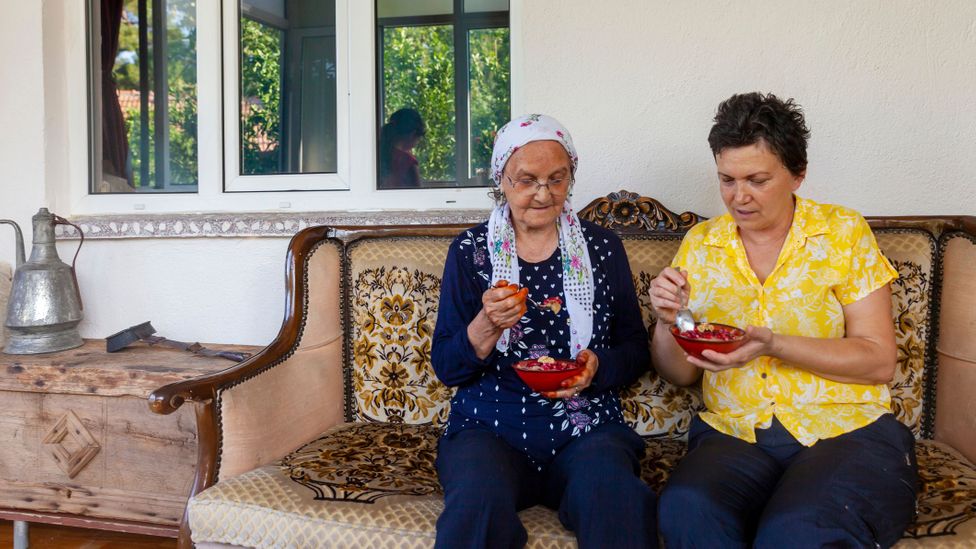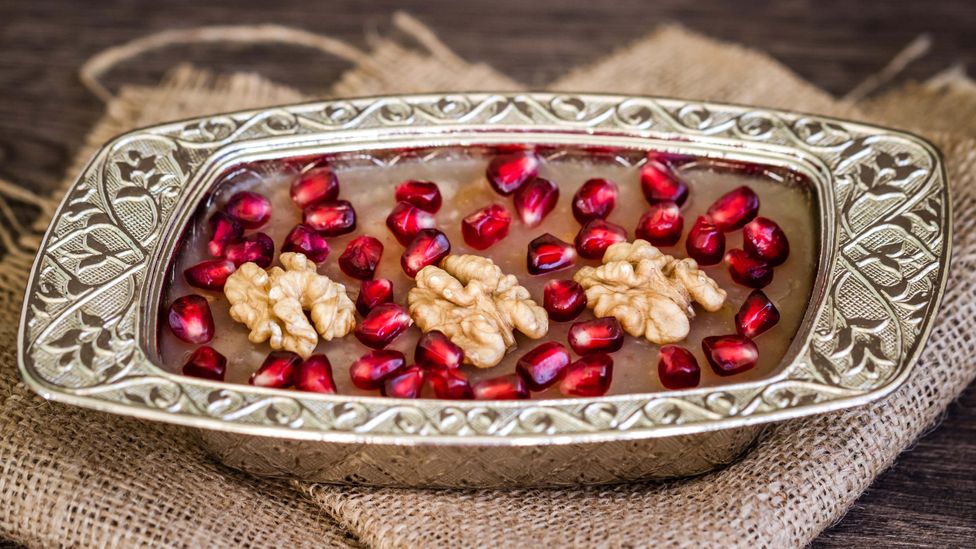The world's oldest dessert?
It was a cold, drizzly January day in Istanbul and I was searching for inspiration at Goreme, an old-school dessert shop in the Kurtuluş neighbourhood. Renowned for its oven-baked pudding and consistently excellent dairy-based desserts, they also offer what is thought to be the oldest sweet treat known to mankind: ashure.
According to Islamic tradition, ashure – which is frequently dubbed "Noah's Pudding" – was prepared as a celebratory dish by the prophet's family after surviving the great flood and washing up on Mount Ararat, on the fringes of what is today the north-eastern borderlands of Turkey. Legend has it that this cornucopia of a dessert, which usually includes around a dozen different grains, fruits, nuts and legumes, was concocted by combining whatever ingredients were still left on the Ark.
The resulting dish is mildly sweet, rich and savoury with notes of fruit. When prepared hot, ashure takes on a comforting consistency resembling porridge; when served cold it congeals and takes on more of a custard-like texture.
Apart from bearing the lofty distinction as the world's oldest dessert, ashure retains important spiritual significance today across Anatolia, the lands comprising the majority of modern-day Turkey.
"Ashure means '10' in Arabic and refers to the 10th day in the month of Muharram, the first month of the Islamic calendar. The dessert is cooked in homes during that week and distributed to friends, symbolising the spread of love and abundance," wrote Vogue and GQ Turkey food editor Cemre Torun in an article for Fool Magazine, noting that ashure is "perhaps the most symbolic dish in this part of the world".
"This date is of particular importance to Shiite Muslims – and of special significance to Alevis and Bektashis – because it represents the martyrdom of Prophet Mohammed's grandson Huseyin, an event that ignited the Shiite-Sunni split in Islam," Torun continued.
Torun's piece explored the culture and culinary habits of her late grandfather, a spiritual leader of the Bektashi faith, a Sufi-inspired sect influenced by Shiite traditions. Though the Bektashis trace their roots to Anatolia, their headquarters moved to Albania after Sufi orders were banned in 1925 by Mustafa Kemal Atatürk, the founder of the Turkish republic. Their belief system is close to that of Alevism, itself a heterodox, non-Sunni religion. Though Alevis constitute 20-25% of the Turkish population, their faith is not legally recognised by the government.
Religion and history aside, Torun told me that ashure reflects the broader attributes of Anatolian cooking.
"The presence of ingredients like chickpeas and beans showcases the importance given to balance and flavours, emphasis on abundance and prosperity, how nutritious the cuisine is in this region, and the importance of the pantry in our kitchens. They are always filled with all kinds of beans, lentils, grains and seeds," she said.
In Turkey and beyond, there are countless varieties and recipes for ashure, owing to the laundry list of ingredients that can be used. Usually vegan, it is chock-full of nutrients and is an ideal winter dessert because it is wholesome and filling.
Suna Cagaptay, a professor of architectural history and archaeology at Istanbul's Bahcesehir University, describes in her article for New Lines magazine about how the storied desert also made its way into Greek and Armenian culinary traditions, and how variants exist across the Middle East and Eastern Europe, though as a child she associated it with where she grew up: the south-eastern Turkish city of Malatya in a neighbourhood inhabited by both Sunnis and Alevis.
"When I was a naïve seven-year-old, I just assumed that the pudding was an Alevi-specific dessert. As a teenager, I realized that Sunnis made it too," Cagaptay wrote.

During the month of Muharrem, ashure is cooked in homes and distributed to friends and neighbours (Credit: Cometary/Getty Images)
I asked Capaptay to recall her and her family's experiences with the traditions surrounding ashure, and she explained how the dish – which her mother served hot using a minimalist eight-ingredient recipe (wheat, sugar, sultanas, chickpeas, white beans, water, cinnamon and walnuts) – is synonymous with sharing, good health, and warm neighbourly relations.
"My earliest memories of the making of the ashure are simply two. The first one takes me back to the moment of holding a little copper bucket filled with a cinnamon/walnut mix and accompanying my mom who would have a big copper bucket of steaming hot pudding and knock on our neighbours' doors. After my mother poured it into each neighbour's bowl, as her busser, I would garnish the pudding. This is of course, a rural way of sharing it," she told me.
You may also be interested in:
• Italy's rare, 2,000-year-old honey
• An immense mystery older than Stonehenge
• A return to vegetarian Jewish cuisine
"In Istanbul or in other cities, you would use your own bowls to share your ashure and garnish it before you take it around," she added.
As a dessert with an ancient history and cultural significance that outpaces most sweets, it was an intimidating subject to tackle. I opted to dive in spoon-first, which is why I wound up at Goreme, a long-time fixture in the Kurtuluş, historically a Greek neighbourhood that retains a cosmopolitan feel and still has a significant Armenian, Greek and Jewish population.
In line with that cultural influence, owner Ilhan Yalcin said the shop's ashure recipe, devised by his grandfather, was based on an Armenian cold soup that could be described as an ashure variant. His version was on the simple side, but still boasted a plethora of ingredients: dried figs, dried apricots, raisins, chickpeas, white beans, oat berries, salt, rice starch, a sprinkle of crushed hazelnuts and a small amount of turmeric, which lent a pleasant yellow hue. The sweetness was natural and not overbearing, with the apricot imparting a surprising tartness.
Dessert shops are likely the best place for visitors to find ashure year-round, as I soon found out. I stopped by the renowned Ottoman restaurant Hunkar only to find out that it was available the day before but not during my visit. I phoned Haci Abdullah, another Istanbul eatery inspired by Ottoman cuisine, and they told me they weren't currently offering ashure, though it is listed on their website's menu. Torun said the reason for this is that some restaurants only serve ashure during the month of Muharram, and there might not be much demand at other times.

Goreme, an old-school dessert shop in Istanbul, sells a simple version of ashure that's based on an Armenian cold soup (Credit: Paul Osterlund)
So, I headed to Saray, a chain of Istanbul pudding shops, which features ashure as a regular fixture on the menu. Saray's ashure was based around the same foundation as the one I had eaten days earlier at Goreme, but intricately topped with fancier ingredients, including shaved coconut and pomegranate seeds.
No matter what ingredients are used, this is a dish that is imbued in nostalgia for many of those who prepare it. After Cagaptay's mother passed away in 2000, she began associating ashure with her and cooked it every year during the month of Muharram for two decades, developing her own recipe during the process. She adds nuts and fruits and serves it cold.
No matter what ingredients are used, this is a dish that is imbued in nostalgia for many of those who prepare it
"I think that when it is eaten cold, it tastes much better as the wheat thickens and all the ingredients blend together really well. As I started cooking the first time, I found myself adding chopped fresh pears and apples, dried figs and apricots, throwing in a cinnamon stick, cloves or whole peeled almonds and adding a handful of rice to make the broth whiter," Cagaptay explained.
"Plus, I always liked to improvise the recipes I learned from my mother. So, again I think that deep down it made me connect with her on another level, thinking that she might have approved of it and enjoyed it very much."
Following years of researching recipes and cooking the dish, Cagaptay has drawn a number of satisfying and meaningful conclusions:
"I loved how ashure or its slight variants symbolises sweetness, commemoration, new beginnings and so on. I think very few recipes have the power of ashure: widely known, bearing Biblical and Muslim references, and directing us to think along similar lines."
Culinary Roots is a series from BBC Travel connecting to the rare and local foods woven into a place’s heritage.
---
Join more than three million BBC Travel fans by liking us on Facebook, or follow us on Twitter and Instagram.
If you liked this story, sign up for the weekly bbc.com features newsletter called "The Essential List". A handpicked selection of stories from BBC Future, Culture, Worklife and Travel, delivered to your inbox every Friday.

Comments
Post a Comment